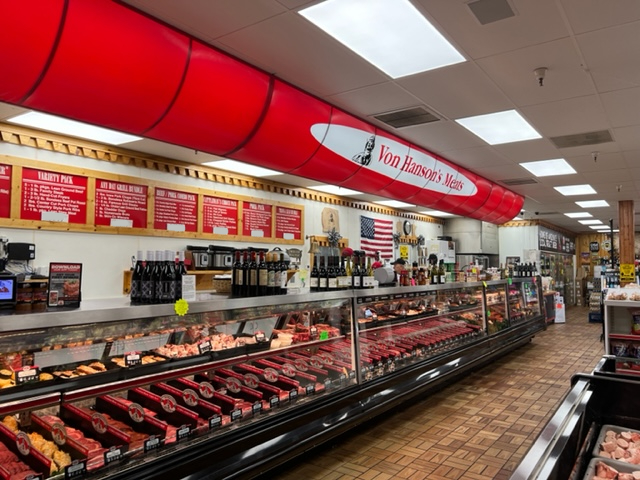Why Citizens Love Bagley Farms Meat Market Edwardsville IL for Their Meat Shopping
Why Citizens Love Bagley Farms Meat Market Edwardsville IL for Their Meat Shopping
Blog Article
Reveal the Art of the Butcher's Cut in a Modern Meat Market
In the ever-evolving landscape of modern-day meat markets, the butcher's cut has transcended its standard roots, combining age-old craftsmanship with modern practices. What truly establishes the contemporary butcher apart is their capability to build a deeper link in between customers and the origins of their meat.
Development of Butchery Methods

The mid-20th century saw butchery techniques further improved by clinical understandings right into muscle mass biology and meat aging, improving both inflammation and taste. Technologies like vacuum cleaner product packaging and refrigeration expanded product shelf-life, permitting butchers to diversify offerings and boost quality assurance. This period additionally noted the rise of specialized devices, such as band saws and meat slicers, which increased precision and efficiency in meat processing.
Computerized systems currently help in monitoring pet provenance and optimizing cuts to fulfill particular customer preferences. Additionally, a revival in artisanal butchery has actually emerged, blending traditional abilities with contemporary expertise to provide to customers looking for moral and lasting meat choices.

Understanding Meat Cuts

Recognizing the complexities of meat cuts is necessary for both butchers and customers seeking quality and value. Each cut originates from a different component of the animal, presenting special tastes, appearances, and cooking methods. Proficiency of these differences not just improves cooking experiences however additionally makes the most of the energy of each carcass. For butchers, specific cuts show skill and respect for the craft, making sure very little waste and optimum yield.
The primary categories of meat cuts consist of primitive, sub-primal, and retail cuts. Butchers then damage these down better into sub-primal cuts, prior to finally creating retail cuts offered to customers, like ribeye or tenderloin.
Understanding muscular tissue structure is critical; muscle mass utilized much more regularly by the pet have a tendency to be harder and are best suited for slow cooking methods, while less-used muscular tissues, like those located in the loin, are more tender and suitable for grilling or roasting. Experience with these distinctions equips consumers to make educated options, boosting their culinary undertakings.
Selecting Top Quality Meat
Picking the best meat entails more than simply choosing an aesthetically appealing item from the screen. The art of picking high quality meat needs a critical eye and knowledge of certain features that represent freshness and excellence.
Second of all, think about over at this website the marbling, which describes the white flecks of fat within the muscle mass. Appropriate marbling is a crucial indication of inflammation and flavor, as it melts during food preparation, improving the meat's juiciness. Remember, higher marbling frequently correlates with exceptional high quality cuts, such as USDA Prime.
Texture is an additional important factor; meat ought to feel firm to the touch, not slimed or overly soft. Additionally, be conscious of the fragrance. Fresh meat should have a clean, neutral smell, devoid of any type of sour or repulsive odors.
Matching Cuts With Cooking Methods
Effectively coupling cuts of look these up meat with the suitable food preparation methods is crucial for accomplishing ideal taste and texture. Various cuts vary in inflammation, marbling, and connective tissue content, each calling for specific strategies to open their potential. Tender cuts like filet mignon and ribeye, with their inherent marbling, benefit from high-heat, quick-cooking approaches such as grilling or pan-searing. These techniques improve the meat's natural flavors and make certain a juicy finish.
Alternatively, harder cuts like brisket and chuck roast are abundant in collagen, which damages down into gelatin when prepared gradually. These cuts are excellent for braising or slow roasting, allowing the meat to soften with time and create deep, complicated flavors. Likewise, cuts such as short ribs and pork shoulder get on well with slow-cooking methods, where prolonged cooking times change their robust textures into succulent meals.
Lamb shanks and oxtail, which call for long term food preparation to tenderize, are ideal candidates for stewing or sluggish simmering. These methods coax out abundant, passionate flavors while maintaining moisture. By recognizing the unique features of each cut, cooks and home chefs alike can boost their cooking productions, making certain each recipe is both satisfying and remarkable.
The Butcher's Role Today
Browsing the advancing landscape of the contemporary meat market, the butcher's duty today expands beyond simple preparation of cuts. Contemporary butchers are cooking artisans, educators, and advocates for sustainable techniques.
Along with crafting accurate cuts, butchers now involve directly with clients, supplying cooking guidance and tailoring choices to suit specific requirements and choices. Their expertise in meat aging, marbling, and flavor accounts equips consumers to make educated choices, enhancing their cooking experiences. This tailored service exemplifies the butcher's progressing role as a relied on expert in the kitchen area.
Moreover, butchers are crucial in reducing waste, Check Out Your URL making use of whole animals to create diverse products such as sausages and stocks - bagley farms meat market edwardsville il. This extensive strategy not just values the animal yet additionally straightens with contemporary sustainability goals. This way, the modern-day butcher embodies both custom and development, adapting to an ever-changing market while maintaining the virtuosity and honesty of their craft

Conclusion
The contemporary butcher's craft intricately weaves traditional techniques with modern developments, stressing lasting methods and honest sourcing. Mastery in understanding diverse meat cuts and high quality signs empowers butchers to supply educated suggestions, lining up specific cuts with optimum cooking methods. This proficiency not only boosts cooking experiences yet also reinforces the link in between consumers and the beginnings of their food. By recognizing historic methods while accepting contemporary demands, the butcher's duty stays important in today's advanced meat market.
Report this page